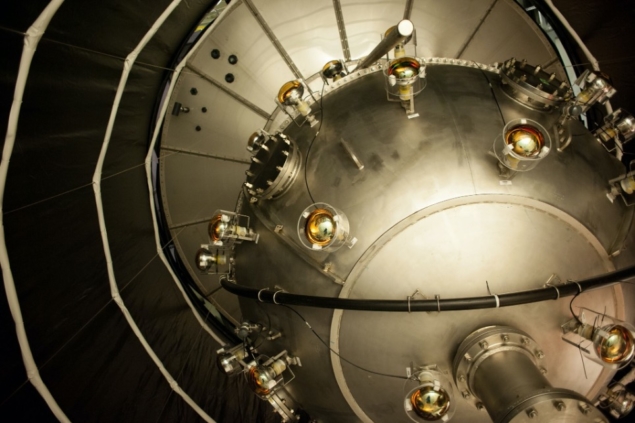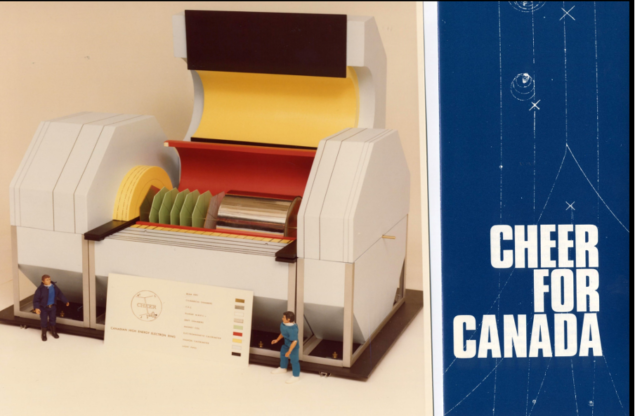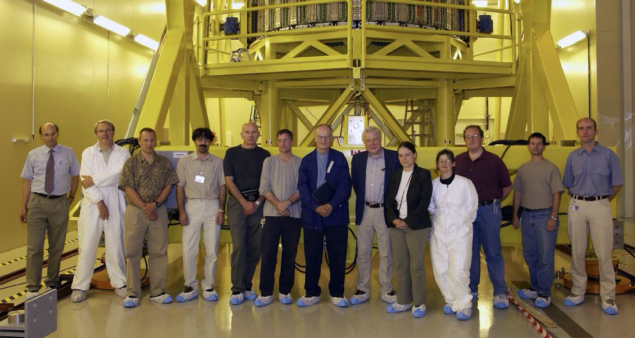Erica Caden, Rob McPherson and Michael Roney look at the history and future of the Institute of Particle Physics as it celebrates 50 years of shepherding high-energy physics in Canada.

Ernest Rutherford’s pioneering work on radioactive decay at McGill University, Montreal, in the early 1900s marked the beginning of Canadian subatomic physics. By the middle of the century, research in nuclear physics and the properties of fissionable material was being conducted at the Montréal Laboratory of the National Research Council of Canada (NRC) and at Chalk River Laboratories, which later became Atomic Energy of Canada Limited, by Bruno Pontecorvo, Bernice Weldon Sargent, Ted Hincks and John Robson, and others. Many Canadian physicists were starting to participate in experiments abroad, and in the 1960s the NRC began funding university professors to work on high-energy physics experiments at US labs. When the US National Accelerator Laboratory (now Fermilab) was approved in 1966, Canadian physicists expressed their strong interest and formed the “200 GeV study group”, chaired by Hincks. Their report, published in March 1969, formed the basis of the foundation of the Institute of Particle Physics (IPP) to steer Canadian involvement at Fermilab.
IPP research scientists are the glue in the Canadian particle-physics community and enable university-based researchers to have an impact in international collaborations.
The IPP serves both as the focal point for particle-physics activities across Canada and as the point of contact for research partners in laboratories and universities worldwide. For the past 50 years, the non-profit corporation owned by institutional members has expanded Canada’s particle-physics programme. Today, it is operated by 17 institutional members, including the TRIUMF laboratory, the Sudbury Neutrino Observatory Laboratory (SNOLAB) and the Perimeter Institute for Theoretical Physics, as well as 230 individual members. In addition to projects at TRIUMF and SNOLAB, IPP members are heavily engaged in international collaborations, such as in ATLAS at CERN and T2K in Japan. Almost all individual members are university faculty or permanent scientific staff working on a diverse set of experiments and theories.
Strong collaboration
The IPP was incorporated on 10 March 1971, with institutional members appointing a board of trustees and electing a six-member scientific council. The board selects the IPP director, who is endorsed by the individual members. Incumbent Michael Roney (Victoria) is the institute’s eighth director.
A cornerstone since the 1970s has been the IPP research scientists’ programme. IPP research scientists serve as the glue in the Canadian particle-physics community and are essential in enabling university-based researchers to have an impact well above what their numbers would warrant in large international collaborations. Recruited by the IPP council via a national and competitive process, each scientist holds an appointment at a host IPP member university, enabling them to work with graduate students, hold grants and undertake long-term stays at international laboratories. This has resulted in significant leadership roles in a number of projects, including ARGUS, OPAL, ZEUS, SNO, BABAR, and more recently ATLAS, T2K, Belle II, SNO+, PICO and DUNE. So far, IPP has had 21 research scientists, 13 of which have either retired or moved to faculty positions.

Promoting participation in large international particle physics experiments by Canadian university-based physicists is a core mission of the IPP. In addition to the work of the IPP research scientist programme, this is accomplished by coordinating particle-physics activities in research and society in Canada and by introducing young Canadians to opportunities in particle physics through the CERN summer student and teacher programmes. Due to its decentralised organisation, individual university interests are parked at the door of the IPP. This enables healthy, vigorous, and highly collaborative teams built from multiple Canadian universities to have a substantial impact in international collaborations.
From CHEER to SNO
The first major IPP project proposal was the Canadian High Energy Electron Ring (CHEER), an electron storage ring feeding off a straight section of the Main Ring to study high-energy electron-proton collisions. Although the 1980 proposal was not approved by the Fermilab directorate, it paved the way for many fruitful collaborations for Canadian physicists. The CHEER team was invited to join HERA at DESY in 1981, which led to a long-term Canadian-DESY collaboration also involving ARGUS, HERMES and ZEUS. Contributions to ARGUS included the construction of the vertex detector’s mechanical structure and the online data acquisition system by Toronto and York universities. For ZEUS, a collaboration between the universities of York, McGill, Toronto and Manitoba from 1987 to 1990 constructed 26 large calorimeter modules. HERA also marked a major Canadian contribution to an offshore accelerator, with a proton transfer line designed and built by TRIUMF and proton-ring radio-frequency cavities built by Atomic Energy of Canada Limited.

Another part of the CHEER team, including Carleton University and the NRC particle physics group, joined the OPAL collaboration at CERN’s LEP collider in 1982. OPAL was the largest particle-physics project in Canada between 1989 and 2000. Canadian teams were responsible for building the detector’s central vertex-wire chamber and “zed” chambers at the outer radius of the large OPAL jet chamber, with the Montréal group building parts of the tracker data acquisition system. In 1992, researchers from TRIUMF and the universities of Victoria and British Columbia, who had constructed part of the SLD calorimeter at SLAC, joined OPAL and deployed its online processing system, while a team from Alberta developed the OPAL scintillating tile end-cap.
IPP’s precision flavour-physics programme using e+e– colliders at the Upsilon resonance began with ARGUS and continued with the BaBar experiment at SLAC’s PEP-II collider. The BaBar drift chamber was built at TRIUMF in the late 1990s in a collaboration with McGill, Montréal, British Columbia, Victoria and US colleagues. In addition to physics positions held by the Canadian team, including three IPP research scientists, they contributed to senior BaBar management roles over the years. Canada’s flavour-physics programme continues today with the Belle II experiment at KEK.
One of the great successes in Canadian particle physics, led by Queen’s, Carleton, Laurentian and other universities, was the Sudbury Neutrino Observatory (SNO). Centered around a 1000-tonne tank of heavy water located at a depth of 2100 m in the Vale Creighton mine in Sudbury, Ontario, SNO was built to investigate the properties of neutrinos and to confront the solar neutrino puzzle. The observatory operated from 1999 to 2006 and its director Art McDonald sharing the 2015 Nobel Prize in Physics for SNO’s contributions to the discovery of neutrino oscillations. Following SNO’s tremendous success, SNOLAB expanded the facility to 5000 m2 of clean and well-equipped underground space for experiments that benefit from the low-background environment. Current IPP projects operating at SNOLAB include the SNO+ neutrinoless double-beta decay experiment, and the DEAP-3600 and PICO direct dark-matter searches. Next-generation dark-matter projects, such as SuperCDMS and the Scintillating Bubble Chamber, are currently under construction.
IPP also has a strong involvement in accelerator-based neutrino projects, in particular the Tokai to Kamioka (T2K) long-baseline neutrino experiment and the new Hyper-Kamiokande experiment in Japan and DUNE in the US, which are both under construction. Canadians were among the founding members of T2K, making strong intellectual contributions to the off-axis neutrino beam concept at the heart of the project. They have led the design and construction of key elements of the ND280 near-detector, which characterises the neutrino beams, and built the optical transition radiation monitor that measures the extremely active neutrino production target.T2K’s remote handling infrastructure was designed and deployed by TRIUMF. Today, Canadian physicists have leadership roles in a wide range of T2K physics studies, including the first indications of oscillations of muon neutrinos to electron neutrinos and placing strong constraints on the CP violating phase in the neutrino-oscillation matrix.
LHC and beyond
ATLAS at the LHC is currently the largest particle-physics project in Canada, with around 40 faculty participants. Canadians were among the founding members of ATLAS in 1992, making key contributions to both the design and construction of parts of the liquid argon calorimeters with additional work on the high-level trigger, pixel detector, transition radiation tracker, luminosity and radiation monitoring, and computing. They are involved in many ATLAS physics studies, and have a leading role in several upgrade projects, including the new muon small wheel, liquid-argon trigger and the silicon-strip detectors for the inner tracker (ITk) detector for the HL-LHC. The LHC is another accelerator complex to which TRIUMF made important contributions, including power supply systems for the proton synchronic upgrades and the quadrupole magnets in the LHC ring used for “scrubbing”.

The also IPP has had a diverse set of projects in the US, including the Large Acceptance Superconducting Solenoid multi-particle spectrometer facility at SLAC (LASS) and the fixed-target experiments E691 and E705 at Fermilab, as well the CDF experiment at the Tevatron. Canadians were also leaders in the rare-kaon decay experiments E787 and E949 at Brookhaven, which made the first observations of the decay of a charged kaon to a pion and a neutrino pair, leading to an involvement in the NA62 experiment at CERN. The precision MOLLER experiment at JLab is another IPP project and IPP is also engaged in the particle-astrophysics projects IceCube at the South Pole, the P-ONE deep ocean neutrino observatory off the Canadian west coast, and VERITAS at the Fred Lawrence Whipple Observatory.
For the past five decades, the IPP has united Canadians working on a diverse set of particle-physics projects, advocated for support by the Canadian government and funding agencies, organised long-range planning for the community, and represented Canada in international committees and steering groups. IPP also employs research scientists playing important roles in international collaborations and enabling Canadian scientific leadership. The IPP continues to support new and novel projects (see figure), while diversifying and extending the Canadian particle-physics programme.







